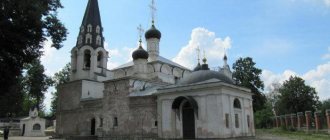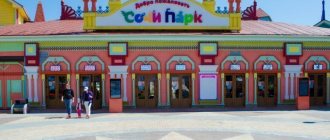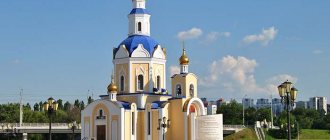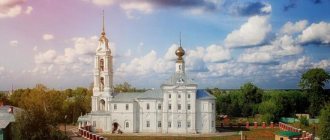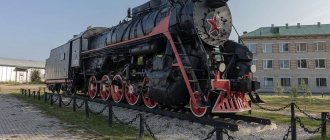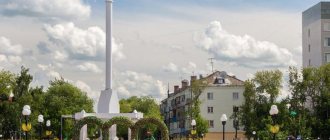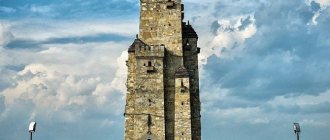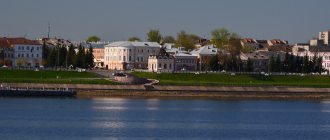Hello dear readers! In this article I will continue my acquaintance with the sights of the city of Belgorod. Let me remind you that the chronology of Belgorod dates back to 1596. I have lived in Belgorod since 1999, and will turn 20 years old this August 2022. You can read how I moved to Belgorod in the article “About the author”.
In the article I will tell you and guide you to interesting places in the city! You will visit the central part of the city on Cathedral Square, where all holidays are celebrated, a Christmas tree and slides are installed on New Year's Day, and of course Victory Day and City Day are celebrated on August 5!
Let's get acquainted with the sights of the glorious city of Belgorod.
Cathedral Square
If you decide to go on a tour of the city of Belgorod, you will definitely be taken to Cathedral Square. This is the most central part of the city and the main city square.
On this square we celebrate the New Year at the main city Christmas tree, celebrate Victory Day and celebrate City Day on August 5th. There are several interesting objects on the square.
In the center of the square in 2000, the so-called “Zero Report” point in the form of a bronze medallion mounted between the tiles.
If you stand on this point, a panorama of the city administration , where local authorities and the “City of Military Glory” stele . You can read about the monument here. On the left is the Belgorod Hotel , a beautiful building with a golden dome and spire.
Behind is the Drama Theater named after M.S. Shchepkin. with a statue of Melpomene - the Muse of Tragedy above the main entrance. The theater is named after a Russian actor born in the Belgorod region. A monument to the actor was erected next to the theater.
If you go left through the square, you will come to the memorial complex “Eternal Flame” . This is a mass grave for soldiers who died in 1918-1919 and 1941-1943. A composition rises above the common grave, a grieving mother and child. An eternal flame burns at the base.
If you look at the map, you can see that all objects are close to each other.
Explanation: 1. Hotel Belgorod, 1; 2. Cathedral Square 1a; 3. Stele “City of Military Glory”; 4. Medallion “Point zero”; 5. Monument. Eternal flame; 6. Drama Theater named after M.S. Shchepkin.
Architectural structure “For the Fallen in Afghanistan.”
Popova Street, Belgorod
- View 1
- View 2
- View 3
Altitude 112 50°35.505′ N. w. 36°35.334′ E. d. (G)
The author of the architectural structure “Fallen in Afghanistan” is local sculptor A. Shishkov. On February 14, 1997, its grand opening took place next to Victory Park in Belgorod at a rally dedicated to the eighth anniversary of the withdrawal of troops from the Democratic Republic of Afghanistan.
Valery Varganov recalls: “The cold and piercing wind chilled more than two thousand of the townspeople present to the very bones; the unseasonably drizzling rain forced them to wrap themselves more and more tightly in their clothes. The delegation from the regions, who arrived by bus, immediately merged with their frozen fellow countrymen. The head of Belgorod local government, Georgy Golikov, opens the rally. For a long, very long time, his father Viktor Nikolaevich Kholintov remembers his deceased son, trembling in his voice. Words of gratitude... Music suddenly sounds loud... Carnations, roses... Dozens of hands carry them to the crucifix. Powerfully, from the secret depths of consciousness, sweeping away everything in its path, the lines break out: “Flowers lie like tears on granite slabs...”.
For Belgorod residents, this monument has become a symbol of heroism, military valor, friendship, loyalty to the oath and eternal memory.
“Dedicated to the memory of those fallen in Afghanistan” read the lines on the architectural composition, which includes memory bells and a Christian cross, overshadowing all the Belgorod residents who died in the hostilities of 1979-1989. on Afghan soil. “Greater love has no one than this, that a man lay down his life for his friends,” is inscribed on the cross. Four memorial plaques bear the names of Belgorod soldiers who died while performing their international duty in Afghanistan.
Historical reference.
During the ten years of the war in Afghanistan, 3,382 Belgorod residents took part in hostilities, 85 did not return home, dying with honor and dignity, one went missing, 746 people were awarded orders and medals. On February 15, 1989, the last units of the limited continent of Soviet troops in Afghanistan left the rebellious country. But the terrible lessons of the bloody war still resonate with pain in our memory. That’s why there are always flowers at the foot of the monument to those who fell in Afghanistan, and every year on the day of remembrance of internationalist soldiers, mourning rallies are held here and wreaths are laid.
Victory Park Belgorod
In the center of Belgorod, on both sides of the Vezelka River, there is Victory Park. The official opening of the park is considered to be 1989. For the steadfastness and courage of Belgorod residents during the war, in 1980 Belgorod was awarded the Order of the Patriotic War, 1st degree. The installed stele with the order at the top tells about this. In fact, Victory Park begins with this stele.
Although you can get into it from different sides. Before entering the park through the alley, we are greeted by a beautiful fountain. In the center of the alley stands the sculpture “Victory in the Patriotic War” .
It depicts 3 figures: a female soldier, a young and an old soldier. Symbolizing the defense of the fatherland through the joint efforts of women, old and young. The monument was opened on August 5, 1983, on the 40th anniversary of the Kursk Bulge.
The park is very cozy, quiet and clean. There are many tall trees between which children's playgrounds are built. There is a site with a built wooden town - this is a whole complex of houses. Modern grounds with rubber covering for sports, tennis courts.
Wooden platforms have been built along the Vezelka River, where you can sit and relax, feed the ducks, and during the match, watch the broadcast and cheer.
In 2001, the Alley of Heroes . There are busts of heroes of Belgorod and Russia installed on it. The alley leads to the monument to G.K. Zhukov , fresh wreaths and flowers are always laid near it. On the Alley of Heroes, at the bottom of each monument there is a sign with a barcode, you take it off with your phone and download the application. And here you go! You can read the entire historical or biographical information about the hero. Very, modern and comfortable!
If you walk forward through the Alley of Heroes and cross the road, you will come to the diorama museum “Arc of Fire”.
What's a park without a concert venue? This is a vacation spot for city residents; on weekends, concerts are held here or we just play music, and the older generation organizes “discos.”
It’s so interesting to see from the side how they try to dance, the women are smart, and the men, as they say, “On parade.”
You can get to Victory Park from Cathedral Square, through the Theater named after. M.S. Shchepkin or from the Kursk Bulge diorama museum
Current problems of the park
The park is one of the few green areas in the center of Belgorod. This is a favorite place for walks and recreation for children and parents. In addition to public events on holidays, townspeople visit here a children's playground, a sports ground, a boat station, and admire the fountains.
But in recent years, the problem of preserving Belgorod’s Victory Park has become acute. The fact is that most of its territory turned out to be swampy. Many beautiful and large trees began to die due to excess moisture. A swamp has formed in the center of the park area, with a characteristic smell and mosquitoes that interfere with the walks of citizens.
The reason for the swampiness is that the favorite vacation spot is located in the river valley. In the spring, after the snow melts, the amount of water in the river increases and flooding begins. Another reason is the rise in groundwater levels due to increased rainfall, and the third is possible leakage of sewer pipes.
In order to preserve the park and solve the problem of flooding of its territories, the city authorities checked the latter and in the future they plan to install drainage structures in flooded areas, plant moisture-absorbing vegetation, and invite landscape designers to improve this part of the territory with the help of an artificial waterfall and moisture-loving vegetation.
Museum Square in Belgorod
In the city center, next to Victory Park, there is Museum Square, as it is called in the city. Residents and guests of the city love to walk here. There are three museums located on this square: the Diorama Museum “Battle of Kursk. Belgorod direction”, Art Museum and Museum of History and Local Lore.
Museum-diorama “Battle of Kursk. Belgorod direction"
In Belgorod they remember the glorious military past and many monuments have been built. One of them is the diorama museum “Arc of Fire,” dedicated to the tank battle near the village of Prokhorovka. The battle took place on July 12, 1943.
Built like a pedestal, the building is shaped like an “arc” and looks like a developing sail. The museum building houses one of the largest canvases in Europe, 67 meters long and 15 meters high, without a single seam. There is a lot to see in the museum. Read a more detailed article about the museum here. Museum opening hours
The last Friday of every month is sanitary day.
The cash register closes 30 minutes before. before closing.
Belgorod State Art Museum
The most beautiful building is the Belgorod State Art Museum. It has 3 floors. The building, built in 2007, has a painted facade and rich decoration in the Russian Art Nouveau style. The painting of the building has a unified theme of nature and man. Floral and antique motifs were used for painting, and bas-reliefs serve as decorative decoration.
The interior of the museum has curved walls, which are decorated with carvings made of wood, forged metal and colored glass.
You can climb to the upper floors via a beautiful staircase made of rare granite and marble.
The huge hall houses the permanent exhibition “National Art of the 20th and 21st Centuries”, as well as 10 to 15 temporary exhibitions.
The cost of a ticket to the permanent exhibition is 38 rubles, to the exhibition hall - 79 rubles. Prices are for 2022.
Belgorod Museum of History and Local Lore
This museum is considered the oldest among the city's museums. Opened back in 1924, it has gathered under its roof the largest number of cultural treasures of Belogorye.
From three small rooms in the closed Trinity Monastery, the museum began its life and history. During the war, all the exhibits were looted and destroyed, and everything that was collected after the defeat was taken away. In 1948, the museum again opened its doors to the public.
Since 1964, a permanent exhibition “Returning the Memory of the Past...” has been opened. The museum contains more than 9 thousand exhibits on archeology, a collection of furniture, various clothes and hats, dishes and much more.
The museum is located at: 308600, Belgorod, st. Popova, 2a.
- Phone: 4722/ 32-16-76
Museum entrance fee:
- without excursion - 56 rubles;
with excursion - 73 rub.
field trips are also available
Cost of services at the museum
Provision of other services:
- Provide consultation from 56 to 90 rubles 1 hour, select documents -56 rubles 1 topic, compile historical information -489 rubles
- Provides assistance in creating traveling mini-exhibitions. Price for 1 exhibition is 917 rubles.
- Provides services for the development and implementation of events. Price is negotiable
The museum provides methodological and practical assistance in creating museums of various types. The service is paid. Price is negotiable.
PREFERENTIAL VISIT TO THE MUSEUM is provided: 50% of the full ticket price (without excursion services) to disabled people of groups I and II.
Content
- 1 Belgorod is a city of military glory.
- 2 Victory Park
- 3 Monument (bust) “Marshal G.K. Zhukov"
- 4 Alley of Memory of Heroes
- 5 Belgorod State Historical and Art Museum-Diorama “Battle of Kursk. Belgorod direction".
- 6 Architectural structure “For the Fallen in Afghanistan.”
- 7 Monument “Army General I.R. Apanasenko"
Belgorod is a city of military glory.
Belgorod
– our small Motherland, rich in its heroic past.
View of the city
Since ancient times, Belgorod has been a warrior city, a reliable outpost on the southern borders of Russia, defending the Russian land from enemy hordes.
During the harsh years of the Great Patriotic War, the southern face of the Kursk Bulge passed here, where one of the decisive battles of the Second World War took place.
Half of Russia fought here... So many of our people died here. The color of the nation, its pride, glory and future.
The Battle of Kursk, in which almost 4 million people, 13 thousand tanks and self-propelled guns, 12 thousand aircraft and tens of thousands of guns and mortars took part on both sides, ended in the defeat of the German troops. This was a radical turning point in the course of the war. The strategic initiative finally passed into the hands of the Red Army. After it, our troops began to advance and “drive” the enemy all the way to Berlin.
August 5, 1943
Soviet troops recaptured the cities of Orel and Belgorod from the enemy. On this day, in the sky above the capital, Muscovites saw volleys of festive fireworks for the first time in the entire war.
In this regard, the poet Alexander Tvardovsky wrote:
“And the voice of festive guns In the hearts of excited people Was an echo of menacing everyday life, Was the thunder of our batteries. And every house, and alley, And with every stone, all of Moscow Recognized words in these rumbles - Orel and Belgorod. So Belgorod
became the city
of the First Salyut
Salyut
Therefore, many streets, parks, squares, squares and monuments of the regional center are associated with the victory in the Great Patriotic War and the names of those heroes who courageously fought to liberate Belgorod from the fascist invaders. These monuments, museums, and architectural structures are designed to convey the people's grief and inescapable sadness for the dead, as well as eternal gratitude to them and the bright memory of their descendants.
“...Years have passed.
The fighting began. Neighborhoods have already grown. And in honor of the living soldiers, and those who fell, and defended our Belgorod in battles, they named the streets at the former frontier.” L. Kuzubov
Drama Theater named after M.S. Shchepkin Belgorod
Theater named after
M. Shchepkina was built in 1962 and is very popular. His performances are always sold out and it is not always possible to buy tickets even a month in advance. The theater is famous for the great actor M.S. Shchepkin. A monument was erected in his honor near the theater on the street.
The theater's repertoire is varied, including classical productions and modern productions, comedies, plays, and children's plays. The location of the theater on the map of Belgorod, opening hours and how to call can be seen in the figure below.
PARK MANAGEMENT OF THE CITY OF BELGOROD AS THE ARCHITECTURAL AND ARTISTIC APPEARANCE OF THE CITY
The landscape of a modern city reflects all the diversity and inconsistency of the processes occurring in it. The interaction of the natural and artificial environment is increasingly taking the form of increasing pressure from urban development on the environment.
As the pace of urbanization increases in the areas of the largest cities, the quality of life of people is increasingly determined by the degree of preservation of the components of the natural environment.
Currently, special attention is paid to the improvement and landscaping of the urban environment, as evidenced by the fundamental transition from solving purely utilitarian problems to creating a harmonious environment that has a certain aesthetic value, regardless of the size and significance of the object in the structure of the city.
Improvement of the city territory is one of the life-supporting areas of the urban economy, which has a direct impact on the quality and standard of living of the population.[8]
An integral part of the landscaping of a large city are plantings in the suburban area, creating conditions for mass recreation of the population in the natural environment and promoting the improvement of the urban air basin: forests and forest parks, orchards.
Green spaces in recreation areas of the urban population form forests, groves, groups of trees and shrubs, alleys, hedges, trimmed walls and bosquets; Decorative lawns and flower plantings, and vertical gardening are also created. An important task is to create an organic relationship between plantings and natural and artificial reservoirs, terrain and architectural structures.
Not all plants are able to survive in urban conditions. Trees and shrubs planted on dusty streets must withstand the powerful onslaught of civilization. We want plants not only to please our eyes and give us coolness on a hot day, but also to enrich the air with life-giving oxygen.
Environmental monitoring in the city should monitor and study the nature and degree of environmental pollution, the state and efficiency of life and “work” of green spaces. Green spaces of the city, fulfilling their sanitary, hygienic and decorative functions, are designed to ensure the creation of comfortable or close to such living conditions for the population. Studies have shown that green spaces, depending on the density, height and width of plantings, can increase air humidity by 14% or more, soften the amplitude of air temperature fluctuations by 2-3°, reduce wind speed by 40% or more, and reduce direct solar radiation by 20-50%, reduce air dust by 40% and noise by 22%, the content of harmful gases by 14-30%, increase the number of cloudy days and precipitation by 5-10%.
Air purity can be assessed using higher plants. For example, gymnosperms are excellent indicators of atmospheric purity. It is also possible to study mutations in the hairs of the stamen filaments of Tradescantia. French scientists noticed that with an increase in carbon monoxide and nitrogen oxides emitted by internal combustion engines in the air, the color of its staminate filaments changes from blue to pink. The consequences of disturbances in the individual development of plants can also be identified by the frequency of occurrence of morphological deviations (phenodeviants), the value of fluctuating asymmetry indicators (deviation from perfect bilateral and radial symmetry), and by the method of analyzing complex structures (fractal analysis). The levels of any deviations from the norm are minimal only under optimal conditions and increase under any stressful influences.
In the leaves of a tree, chlorophyll grains absorb carbon dioxide and release oxygen. Under natural conditions in summer, an average-sized tree in 24 hours releases as much oxygen as is necessary for the breathing of three people, and 1 hectare of green space absorbs 8 liters of carbon dioxide in 1 hour and releases into the atmosphere an amount of oxygen sufficient to support the life of 30 people. Trees remove carbon dioxide from the ground layer of air approximately 45 m thick.
They are rich in phytoncides against bacteria: the needles of perennial fir and young shoots of pine and spruce. The fruits of ash are not affected by bacteria and fungi; they are “bypassed” by insects and birds. Siberian cedar, larch, Siberian princeling, bird cherry, and juniper also have bactericidal properties.
Rainwater flowing from cedar, fir, rowan, bird cherry, and elderberry has a detrimental effect on mushrooms.
From all of the above, we can conclude that green spaces serve not only as decoration, they are true protectors of people’s health.
Improvement and landscaping of recreational areas in Belgorod
The Belgorod region is one of the cleanest Russian regions, however, it cannot be called sterile. The main air pollutants are not cement factories and mines, but motor vehicles. Belgorod residents are saved by the abundance of green spaces in the city, which absorb harmful emissions. City authorities are also concerned about the health of citizens and are adopting various programs aimed at improving the environmental situation.
Belgorod can be classified as a well-maintained city; it is not for nothing that the guests of our city are sincerely and pleasantly surprised by the cleanliness, neatness and unique architectural and artistic appearance of the city. This is largely due to the landscaped areas of parks and public gardens, but it is also impossible not to note the presence of unique small architectural forms, including thematic ones.
If we talk about the arrangement of city streets, then we can say that there are few cities where you can still see a beautiful flowerbed, for example, on the dividing strip. This year, the flowerbeds of the regional center are decorated with three million four hundred thousand flowers. Among the various tree species used for urban landscaping, chestnut . One mature chestnut tree clears a space of up to 20 thousand m3 from incoming exhaust gases. Moreover, unlike many other trees, chestnut decomposes toxic substances with almost no damage to its health.
Resistant to air pollution and poplar. In terms of the amount of absorbed carbon dioxide and released oxygen, a 25-year-old poplar exceeds spruce by 7 times, and in the degree of air humidification - almost 10 times. So, to improve the air quality, instead of seven spruces (three lindens or four pines), you can plant one poplar, which also catches dust well.
Tree foliage actively traps dust and reduces the concentration of harmful gases, and these properties manifest themselves to varying degrees in different species. The foliage of elm and lilac holds dust well (better than poplar leaves). Thus, a planting of 400 young poplars captures up to 340 kg of dust during the summer season, and elm – 6 times more. Acacia, unpretentious fast-growing rose hips and a number of other plants also have similar properties.
Planting red elderberry, red oak, and serviceberry perform the most effective noise-protective functions.
Interestingly, sounds are not absorbed by the foliage of trees. Hitting the trunk, sound waves are broken, heading down to the soil, where they are absorbed. Spruce is considered the best guardian of silence. Even next to the noisiest highway, you can live peacefully if you protect your home with a row of green fir trees. And it would be nice to plant chestnuts nearby. Juniper is planted everywhere, lilac and other highly decorative perennial plants and shrubs appear in the city.
The Central Park of Culture and Leisure in Belgorod opened in 1956. Thousands of different trees were planted here.
On the territory of Victory Park there are 14 species of trees and shrubs, of which species such as smooth elm, mountain ash, pyramidal poplar, western thuja and Scots pine have the most “unsatisfactory” trees that need to be replaced.
The recommended assortment was selected as a result of a comprehensive analysis of the soil and environmental conditions of park areas. For Victory Park, the assortment includes 21 species (common spruce, horse chestnut, red oak, field maple and others).
Every year in Belgorod, existing alleys, parks and squares are reconstructed. This is how S. Yesenin Square on the street of the same name would have been laid out in 2011. In honor of this event, a memorial stone was erected.
The main thematic content of the park consists of small architectural forms and sculptures. In addition to the sculpture of the poet himself, in the park there is a unique monument to Kachalov’s dog, which became the hero of a famous poem, and it is also worth noting an interesting embodiment of the talent of the great Russian poet in the form of a monumental book.
Yeseninsky Square is a circular walking alley with two nodal points, in the center of one of which there is a gazebo, and in the other there is a round platform for public events, decorated with a rotunda with columns
An analysis of the structure of green spaces in the city of Belgorod shows that the city has plantings of various categories: a) public use (yard gardens, squares, boulevards, recreation and recreation parks, country parks; b) limited use (gardens and parks of medical institutions, schools, children's gardens, enterprises, etc.); c) green spaces for special purposes (zoo, cemetery gardens, nurseries, a botanical garden has been established).
The share of green area is 31.5%. This is 8.5% below the accepted norm. Based on this, we can conclude that there is a lack of landscaping in the city of Belgorod.
If we talk about such a phenomenon as a flower bed, then it is involved in decorating not only cottages and dachas. It is impossible to imagine modern cities without squares and parks, squares and stadiums, quiet city courtyards and wide avenues, the brightest attraction of which are colorful flower beds.
An obligatory element of any green construction are flower beds, which include flower beds, ridges, groups, single and other plantings against the backdrop of a lawn.
In Belgorod, a visitor should definitely be struck by the passion of the townspeople for flowers.
Flower baskets have recently become common among Russian citizens. But vertical flower beds are just beginning to take over our streets. They are containers for plants arranged in tiers. This design does not require much space at the base, but has a large effective volume for planting plants vertically, which significantly increases the total area of urban gardening, and therefore is very environmentally friendly. Such flower beds are in perfect harmony with the verticals of multi-storey buildings and with the open space of squares, but are especially indispensable where the territory is limited.
Plants in vertical flowerbeds, due to their tiered arrangement, are in equal conditions with regard to growing conditions - light, humidity, nutrition. With the exception of watering, they require virtually no maintenance - loosening, weed control, which significantly reduces maintenance costs. You can even skip the planting stage by purchasing or renting ready-made vertical flower beds with well-grown plants that immediately have a highly decorative appearance. In Belgorod, such flower beds can be seen along Vatutina Street.
You can often find flower beds having an unusual shape, for example, in the city of Belgorod, near one of the bypass roads there is a huge flower bed in the shape of the Belgorod region, and opposite the monument to Prince Vladimir, for many years the area adjacent to the highway has been decorated with a flower bed in the shape of a clock, which not only pleases with its flowering in spring and summer, but also shows the exact time.
Small architectural forms of Belgorod
New monuments and sculptures appear in Belgorod every year. For example, over the past few years, a monument to a surveyor, a monument to a local historian, a monument to police dog handler Fyodor Khikhlushka, a monument to students and a monument to engineer V.G. Shukhov appeared on the territory of BSTU. Shukhov, monument to gymnast Svetlana Khorkina. The square in front of the BelSU National Research University is decorated with a fountain with a monument to the Archangel Gabriel erected above it. Near the Drama Theater. Shchepkin there is a statue of actor M.S. Shchepkin, and the territory of the square behind the theater is decorated with the sculptural composition “Memory” depicting an old woman doing needlework. Some streets named after famous personalities are decorated with bust sculptures. For example, a monument to Marshal I. Konev, N.A. Shchors, and Prince Trubetskoy. And of course, we must not forget about the numerous monuments, memorial complexes and sculptural compositions dedicated to the fallen heroes of the Great Patriotic War.
In addition, sculptures made from natural and polymer materials contribute to the artistic appearance of the city. Such as the “Boar Family”, Elks, Deer, Bears, etc. All of them have been decorating our city for many years and never cease to amaze not only visitors, but also citizens.
In Belgorod you can see many fountains, such as the “Patron” fountain - near the walls of the National Research University of Belgorod, a fountain on the embankment of the Vezelka River, the Friendship Fountain on the territory of BSTU. Shukhov Easter fountain in Love Square and many others.
Some parks and squares in Belgorod are thematic in nature, such as Victory Park or Pushkin Alley on the territory of BSTU. Shukhova.
Every year more and more yards become landscaped and landscaped. It’s not for nothing that the city of Belgorod is called the Green Capital.
Bibliography:
- Bioindication of pollution of terrestrial ecosystems / Ed. R. Schubert. M.: Mir, 1998.
- Environmental monitoring (Ecological monitoring). Dyachenko I.G. Novosibirsk-2003
- Chemical elements in plant life. / Protasova N. A., Belyaev A. B. //Soros Educational Journal volume 7 No. 3 2001. Art. 25 –33.
- Nikolaevskaya I.A. Improvement of territories - M., 2006
- Polivanova D.Yu., Zatolokina N.M. Monitoring of green spaces in the city of Belgorod // International scientific and technical conference of young scientists of BSTU. V.G. Shukhova. [Electronic resource] 2015
- Polivanova D.Yu., Zatolokina N.M. Monitoring of green spaces in the city of Belgorod // VII International Student Electronic Scientific Conference “Student Scientific Forum 2015” RAE. [Electronic resource] 2015
- Zatolokina N.M., Bobyleva E.V. Current state of recreational areas in Belgorod // Materials of the International Scientific and Practical Conference “Architecture, construction, land management and cadastres in the Far East in the 21st century”, Komsomolsk-on-Amur, 2015./ KnAGTU-p.323
- Resolution of the Belgorod city administration dated November 6, 2014 No. 219 “On approval of the municipal program “Development of housing and communal services of the city of Belgorod for 2015-2020”
- [electronic resource] free access.
- [electronic resource] free access.
- https://www.belpravda.ru/taxonomy/term/38/all [electronic resource] free access.
Belgorod Zoo.
Where to go with a child in Belgorod? The city has many places to keep children of all ages entertained. I want to tell you about the zoo, which recently moved to a new territory.
In clean and free enclosures, the life of animals is close to natural conditions. Many of them are recorded in the Red Book. In addition to the usual inhabitants of forests, you can also see desert inhabitants and get acquainted with reptiles in a separate building of the Exotarium.
And the open “Granny’s Yard” will delight kids with close contact with animals that they can pet and feed by hand.
Read a detailed article about the zoo here.
The zoo is located at: Russia, Belgorod, Volchanskaya street, 292 century.
Ticket prices:
- Adult ticket (from 16 years old) - 300 rubles.
- Preferential categories of citizens* (pensioners, disabled people of group 3, large families, 1 accompanying disabled child) - 100 rubles.
- Preferential categories of citizens* (large families) - free (first Saturday of the month).
- Disabled children, disabled people of groups 1 and 2* - free.
- WWII* participants - free.
- Children's ticket (under 5 years old and disabled children under 18 years old) is free.
- * Discount ticket is provided if you have documents confirming your identity and benefit./li>
Child ticket (from 5 to 16 years old) - 100 rubles. (Teenagers 14, 15 years old must present a passport).
Alley of Memory of Heroes
Victory Park
Alley of Heroes
Altitude 122 50°35.500′ N. w. 36°35.132′ E. d. (G)
The memory of the hero-liberators, of those who gave their lives for the liberation of the Belgorod region and other territories of the country from the Nazi invaders, of the Heroes of the Soviet Union and Heroes of Russia - Belgorod residents - is immortalized in the Alley of Memory of Heroes in Victory Park. The alley was inaugurated on May 9, 2000. 12 metal busts of Belgorod Heroes of the Soviet Union and Russia were installed on granite pedestals. V.V. Burtsev and A.I. Orlov (author of the busts, sculptor D. Gorin), N.T. Lukinov and N.I. Tyusin (author of the busts, sculptor A. Pshenichny), N.N. Kononenko and K.A. Limansky (author of the busts, sculptor A. Smely), N.N. Tikhonov and V.P. Khromykh (author of the busts, sculptor M. Smely), N.F. Besedin, V.N. Denisov, P.P. Zyubin and N.P. Kramchaninov (author of the busts, sculptor A. Shishkov). The author of the project for the Avenue of Heroes is the architect V. Salonnik. The presence of individuality in the handwriting of different sculptors introduced an interesting variety of characters in the artistic images of the busts they created.
Belgorod Airport
The airport is the calling card of the Belgorod region. The first thing guests see after arriving is him.
And I want to introduce you to the new and modern airport of the city. I'll tell you where it is :) how to get to it :)
I use the airport services as soon as the opportunity arises and I go on a flight.
Very soon, namely on August 30, 2014, the airport will celebrate its 65th birthday; it is the same age as the Belgorod region. The airport has been operating since 1954.
For more than half a century, this transport enterprise has gone from a field landing site to a modern international-class air terminal complex.
Today Belgorod Airport is the main air gateway to the region. The airport complex is like a mini city, with huge potential, plans and a rich history.
There are many services operating here around the clock that receive and release aircraft, provide services to passengers, and ensure the necessary flight safety.
It is very convenient and comfortable when the airport is located within the city. The airport is located on the central Bohdan Khmelnitsky Street 166, at its northern end, just 4 km from the center.
9 airlines operate regular flights from the airport. They fly to all domestic destinations, starting from the western capitals: Moscow, St. Petersburg and ending with the eastern and northern regions: Novy Urengoy, Noyabrsk, Nyagan, including the southern regions.
In 2011 and 2012, the airstrip and apron were reconstructed, and the airport was allowed to accept Boeing aircraft. Charter flights are operated to Spain, Greece, Turkey, and Bulgaria.
The airport operates 24 hours a day. It has two terminals for international and domestic flights. The interior is comfortable and convenient, there are storage rooms, a mother and child room, cafes and shops.
At a distance from the Airport, one stop away, there is a Bus Station. If you have free time before departure, there is a large Rio hypermarket nearby and next to it a McDonald's where you can have a delicious meal.
You can get to the airport by public transport. It runs well, and if you are not late for your flight, it is very convenient to use. Well, if time is running out, we take a taxi! It costs 200-300 rubles on average.
18
conclusions
It would take a very long time to describe worthy places to visit. And if you want to see all the parks, churches, city museums! A day is definitely not enough for you?
And the DinoPark, which recently opened within the city, amazes with its size and outlandish prehistoric dinosaurs.
A monument to an honest traffic cop, a 300-year-old oak tree growing outside the city, and so on. It would take a long time to list the sights of the city...
With this I want to say goodbye to you. And wish everyone a wonderful and bright mood, like our White City. “City of the First Salute” and “Military Glory”.
If you liked my article, share it with your friends.
Share in the comments where do you like to go the most?
Bye bye.
Sincerely, Irina!
